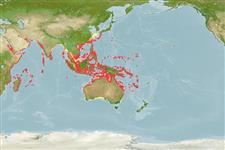Elasmobranchii (tubarões e raias) (sharks and rays) >
Myliobatiformes (Stingrays) >
Dasyatidae (Stingrays)
Etymology: Pastinachus: Latin, pastinaca = a sting ray (Ref. 45335).
Ambiente / Clima / Intervalo
Ecologia
; marinhas; Água doce; estuarina associadas(os) a recifes; anfídromos (Ref. 51243); intervalo de profundidade 0 - 60 m (Ref. 6871). Tropical, preferred ?; 32°N - 37°S, 36°E - 168°E
Indo-West Pacific: Red Sea, Persian Gulf and South Africa to Micronesia, north to Japan, south to Melanesia and the Arafura Sea (Ref. 9819).
Length at first maturity / Tamanho / Peso / Idade
Maturity: Lm ?, range 96 - 100 cm
Max length : 183 cm WD macho/indeterminado; (Ref. 37816); common length : 65.0 cm WD macho/indeterminado; (Ref. 27550)
Espinhos dorsais (total): 0; Raios dorsais (total): 0. A large, plain, dark stingray with an angular snout and pectoral disc; tail long and broad-based, less than twice body length, and with no upper caudal finfold but with high lower caudal finfold- 2 to 3 times depth of tail but not reaching tail tip; no large thorns; 1 or 2 long stings on tail, further behind tail base than in most stingrays; unique hexagonal, high-crowned teeth (Ref. 5578). Dark brown or black dorsally without conspicuous markings, white ventrally (Ref. 5578). Tail black (Ref. 3263).
Found in lagoons, reef flats, and reef faces (Ref. 12951). Also in rivers far from the sea (Ref. 5578). Feeds on bony fishes, worms, shrimp, and crabs (Ref. 12951). Ovoviviparous (Ref. 50449). Adults are sometimes accompanied by remoras or members of the trevally family (Ref. 6871). Size at birth about 18 cm WD or larger (Ref. 6871). Flesh utilized as food and skin used for polishing wood (Ref. 4832). Possibly caught by sports anglers (Ref. 5578). Recently there is a targeted fishery on this species for its skin, which is used as 'shagreen' in fashion accessories, from wallets to fancy pens; as a result, the species is in danger of disappearance (IHT 26.11.2005, p.5). Maximum length about 300 cm TL (Ref. 30573).
Life cycle and mating behavior
Maturidade | Reprodução | Desova | Ovos | Fecundidade | Larvas
Exhibit ovoviparity (aplacental viviparity), with embryos feeding initially on yolk, then receiving additional nourishment from the mother by indirect absorption of uterine fluid enriched with mucus, fat or protein through specialised structures (Ref. 50449). Distinct pairing with embrace (Ref. 205). Size at birth ~ 18 cm WD (Ref.58048).
Last, P.R. and J.D. Stevens, 1994. Sharks and rays of Australia. CSIRO, Australia. 513 p. (Ref. 6871)
Status na Lista Vermelha da IUCN (Ref. 115185)
CITES (Ref. 94142)
Not Evaluated
Perigo para os humanos
Venomous
Uso pelos humanos
Can't connect to MySQL database (fbapp). Errorcode: Too many connections
